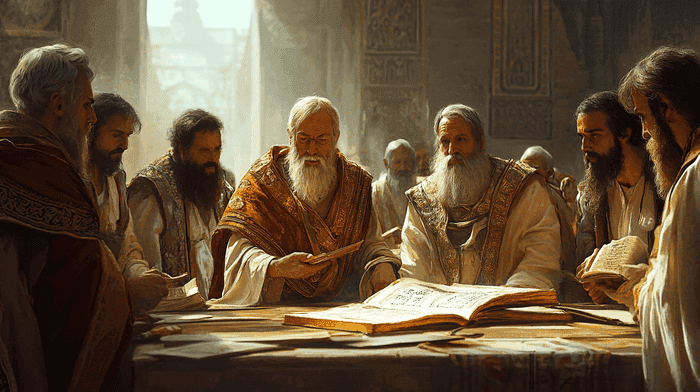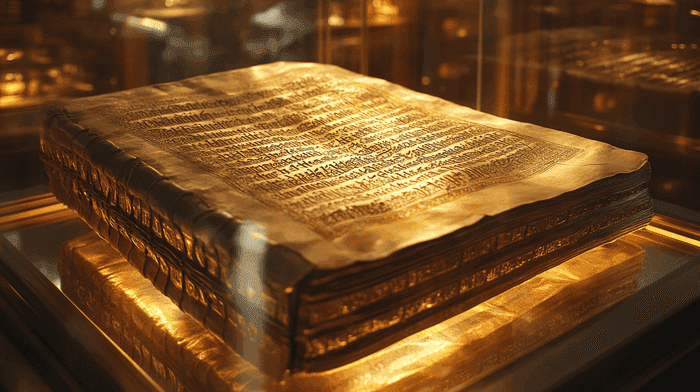Let’s Start With the Obvious: Enoch’s Name Is in the Bible
Before we even talk about the Book of Enoch, let’s talk about the man himself. Because yes, Enoch is in the Bible. He’s not just some fringe figure pulled from ancient conspiracy blogs or buried apocryphal texts. He’s right there in Genesis, walking so closely with God that he never actually dies:
“And Enoch walked with God; and he was not, for God took him.” — Genesis 5:24 NKJV
Just like that. Enoch vanishes from the earthly scene with the same mystery that surrounds him today. This single verse has sparked centuries of questions: Who was Enoch? Why did God take him? And... what else don’t we know?
He pops up again in the New Testament. The author of Hebrews lists him among the faithful:
“By faith Enoch was taken away so that he did not see death, ‘and was not found, because God had taken him’; for before he was taken he had this testimony, that he pleased God.” — Hebrews 11:5 NKJV
And perhaps the biggest shocker is that he’s quoted in the New Testament, specifically in the tiny Book of Jude:
“Now Enoch, the seventh from Adam, prophesied about these men also, saying, ‘Behold, the Lord comes with ten thousands of His saints, to execute judgment on all…’” — Jude 1:14–15 NKJV
Jude is citing a prophecy straight from the Book of Enoch, meaning, at least at that point in early Christianity, the text wasn’t considered all that fringe.
So, we’ve got:
- A man who didn’t die.
- A guy commended for his closeness with God.
- A figure quoted as a prophet in the New Testament.
You can see why people would be curious about anything he supposedly wrote. And why it’s strange (not to mention controversial) that his book didn’t make it into most Bibles.

Representation of the mysterious Enoch (image generated with Midjourney)
What Is the Book of Enoch?
First things first: calling it “the Book of Enoch” is kind of misleading. What we usually mean is 1 Enoch, and it’s not one neat little scroll. It’s more like a five-part anthology of ancient apocalyptic imagination, stitched together over time.
Most scholars agree that the core parts were written between the 3rd century BCE and the 1st century BCE, in various hands and stages. It wasn’t dropped out of the sky in one piece. It evolved, copied, passed around, and added to.
So what’s in it?
1. The Book of the Watchers
This is the part that grabs most people: the story of angels (called “Watchers”) who descend to earth, fall in love with human women, and father the Nephilim, a race of giants. Sound familiar?
Probably because it expands wildly on that cryptic verse in Genesis:
“The sons of God saw the daughters of men, that they were beautiful; and they took wives for themselves of all whom they chose.” — Genesis 6:2 NKJV
Enoch’s version turns that tiny verse into an entire saga, complete with divine punishment, heavenly secrets, and rebellious angels teaching humans things like metallurgy and sorcery.
2. The Book of Parables
Also known as the Similitudes, this section introduces a messianic figure called “the Son of Man”, long before that phrase was linked to Jesus in the Gospels. It’s loaded with judgment scenes and end-times prophecies.
3. The Astronomical Book
This part maps the movements of the sun, moon, stars, and seasons, trying to explain how the heavens work. It’s surprisingly technical and shows just how much Enoch was seen as a revealer of mysteries.
4. The Book of Dream Visions
A wild prophetic tour through history in the form of animal allegories (people represented by beasts). Some say it’s a coded retelling of Israel’s past, from Adam to the Maccabees.
5. The Epistle of Enoch
A series of moral and apocalyptic warnings about the fate of sinners, final judgment, and the vindication of the righteous.
Overall, this is not your average devotional read. But despite the flying angels, talking animals, and cosmic maps, this wasn’t considered “fringe” in ancient times. It was popular. Revered. Quoted.
Which makes the next question even more interesting: why did it fall out of favor?
Get Closer to God Today
4.9
Average Rating
|Over 5 Million Downloads
The Book Was Popular Until It Wasn’t
In the centuries before and just after Jesus, it was widely read and respected by Jewish groups, especially the ones we now call apocalyptic or sectarian, like the people who wrote the Dead Sea Scrolls.
You can see its fingerprints all over ancient thought:
- Those themes of divine judgment, heavenly visions, and angelic rebellion show up in Daniel, Revelation, and even some of Jesus’s own parables.
- Early Christian writers like Tertullian and Athenagoras quoted it with no shame. Tertullian even argued that it should be considered scripture.
- And again, Jude literally quotes it.
So what happened?
When the Church started deciding what counted as scripture, a key test was: Did the apostles write it? Or at least endorse it?
The problem is, the Book of Enoch was written long before Jesus and the apostles. Even though Jude quotes it, the book itself didn’t have that early Christian stamp of approval. That hurt its chances.
Over time, it started being labeled as pseudepigrapha. That’s a fancy way of saying, “It’s written under a fake name.” The real Enoch (the one from Genesis) lived way before writing was even a thing.
So scholars and leaders assumed (rightly) that someone else wrote it and just used his name to give it weight. That wasn’t uncommon in ancient texts, but for canon purposes, it was a dealbreaker.
The Book of Enoch leaned heavily into a view of the world where the fall of angels explained human sin. That’s a different tone than the Genesis account or Paul’s epistles, which focus on human choice, Adam, and free will. The Church didn’t want theology getting too tangled.
So by the time the biblical canon was taking shape (around the 4th century CE in the West), Enoch was already on the chopping block. Revered by some, ignored by others, and officially excluded by most.
Except one group didn’t let go. And that made all the difference.

Early church leaders reviewing ancient texts (image generated with Midjourney)
Lost and Found: Ethiopia Said, “We’re Keeping It.”
While the rest of the Christian world was debating what to include in the canon (and quietly leaving Enoch out), one church held the line: the Ethiopian Orthodox Tewahedo Church.
To this day, 1 Enoch is part of their biblical canon. How? Because they never lost it.
Ethiopia had early exposure to Christianity, dating all the way back to the 4th century. And while the Roman and Eastern churches were working out their theological differences in councils, Ethiopia developed its tradition a bit more off-grid, geographically and doctrinally.
That meant their Bible grew in slightly different directions. And unlike the rest of us, they never tossed Enoch out with the “pseudepigrapha” label.
Their version of the book was preserved in Ge’ez, an ancient Semitic language that’s still used in Ethiopian liturgy. If it weren’t for Ethiopia, there’s a decent chance we’d know about the Book of Enoch the way we know about, say, the Gospel of Thomas or the Apocalypse of Baruch: vaguely. Abstractly. Through footnotes in dusty theological papers.
Instead, we’ve got full manuscripts. This is also how it ended up back in the Western world. In the 18th century, a Scottish explorer named James Bruce traveled to Ethiopia and brought back several Ge’ez manuscripts. Western scholars were stunned. They hadn’t seen the full book in over a thousand years.
But the real bombshell came in the 20th century. In 1947, a Bedouin shepherd tossed a rock into a cave near Qumran and accidentally triggered one of the most significant archaeological finds of all time: the Dead Sea Scrolls. Among the scrolls were fragments of the Book of Enoch.
These were written in Aramaic, the common language of Jesus and the apostles. That confirmed the book had deep Jewish roots and was being read in the centuries leading up to the New Testament.
So now we had:
- Ethiopian manuscripts in Ge’ez
- Aramaic fragments from Qumran
- Quotations in Jude
- Echoes in early Christian and Jewish thought
But even with that rediscovery, most churches didn’t re-adopt it. Too much had changed. The canon was already locked.
Still, Ethiopia kept reading what others forgot. And that’s how the Book of Enoch managed to survive, not just in fragments, but in full.
And now that it’s back, people can’t stop reading it. For better or worse.
So, Why Isn’t It in Your Bible?
The answer to this question isn’t simple, but it’s not some grand conspiracy either. It’s a mix of theology, credibility, and the slow grind of institutional decision-making.
Here’s the breakdown:
1. It Was Too Apocalyptic (And a Bit Too Wild)
Enoch is packed with apocalyptic visions, cosmic battles, fallen angels, and divine secrets. It leaned into a worldview where angels were the villains, and their sins explained humanity’s fall. That didn’t sit well with later Christian theology, which put the blame squarely on Adam and human free will.
2. No Apostolic Stamp of Approval
By the time the Church was sorting out its canon (roughly 4th century CE in the West), one big question guided decisions: Was this written or approved by the apostles? Enoch was not even close. It was written hundreds of years before Jesus. Even though Jude references it, none of the apostles explicitly taught from it. That made it risky to include.
3. Pseudepigrapha Problems
As we touched on earlier, Enoch didn’t write it. Writing under a revered figure’s name was common in ancient literature, but it didn’t pass the test for canonicity. Books like 1 Enoch got swept up into the category of “pseudepigrapha”, texts with unknown or fictional authorship.
4. It Wasn’t in the Hebrew Bible
This one matters more than people think. The Christian Old Testament is, at its root, based on the Hebrew Bible. The Book of Enoch didn’t make it into the Jewish canon either. That fact alone carried major weight when early Christians were assembling their Scriptures.
5. It Disappeared from the West
Once the book fell out of favor and out of circulation in Europe, it essentially vanished for over a thousand years. By the time it was rediscovered, the canon had long been set. It’s hard to get invited back to the party after that much time has passed, especially when your stories involve angel-human hybrids and heavenly time zones.

Rare manuscript of the Book of Enoch in Ge’ez script (image generated with Midjourney)
Get Closer to God Today
4.9
Average Rating
|Over 5 Million Downloads
Final Thoughts
The Book of Enoch is one of those texts that refuses to be forgotten. Quoted in Jude, echoed in early Christian writings, and preserved faithfully in Ethiopia, it walked a strange line between revered and rejected. It wasn’t excluded because no one knew about it. It was excluded because it didn’t fit the final theological puzzle the early Church was putting together.
But that doesn’t make it irrelevant. Far from it.
Enoch gives us a glimpse into how ancient people understood heaven, angels, judgment, and the supernatural. And whether or not you think it belongs in the canon, it definitely belongs in the conversation.
If this article stirred your curiosity, you’re not alone. The Bible Chat App was built for questions like this: about the Bible, the books around it, and everything in between. You never know what unexpected insight might meet you there.
References
- Nickelsburg, George W. E., 1 Enoch: A Commentary on the Book of 1 Enoch, Chapters 1–36; 81–108, Minneapolis: Fortress Press, 2001.
- VanderKam, James C., Enoch and the Growth of an Apocalyptic Tradition, Washington, D.C.: The Catholic Biblical Association of America, 1984.
- Charlesworth, James H. (ed.), The Old Testament Pseudepigrapha: Volume 1 – Apocalyptic Literature and Testaments, New York: Doubleday, 1983.
- Reed, Annette Yoshiko, Fallen Angels and the History of Judaism and Christianity: The Reception of Enochic Literature, Cambridge: Cambridge University Press, 2005.
- Collins, John J., The Apocalyptic Imagination: An Introduction to Jewish Apocalyptic Literature, Grand Rapids: Eerdmans, 2016 (3rd ed.).










